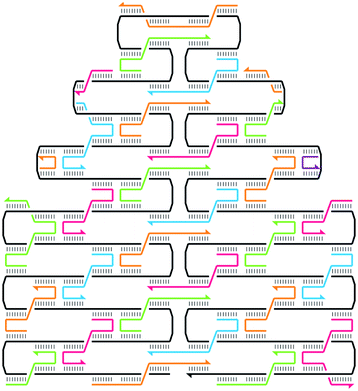
Why was DNA Origami created?
Origami is no longer limited to just paper, but DNA as well. From "genes to machines", DNA can serve as the material for many useful purposes that can bring many benefits to our world. Scientists have been trying to build machines using DNA for many years, however their size and complexity have been constrained. "The problem is that we don't just want to make small stuff, we want to make complicated small stuff, cheaply and easily," says Paul Rothemund, a bioengineer at the California Institute of technology. To solve this problem, Rothermund has created a method called DNA Origami.
Paul Rothemund explains how DNA sequences are used as a "spell".
What is DNA origami?

DNA origami, also known as DNA folding, is involved in DNA nanotechology which is the "design and manufacturing of articficial nucleic acid structures for technological uses." Similarily to traditional origami, DNA origami is the folding of synthetic DNA (instead of paper) to create two and three dimensional structures at nanoscale (1-100 nanometers). DNA is the chosen construction material to be used because of its base pairs rules, and it is a "well-understood material that is suitable for creating scaffolds that hold other molecules in place or to create structures all on its own" for the assembly of computer-chip elements.
The process of DNA origami is constructed and designed on a computer device and is then printed out as the artificial DNA. Figure 3 shows the process of DNA origami.
Steps:
1. Design long and short strands of DNA to bind at specific places (for the desired shape) on a computer and then print out using 3D printing.
2. A long, single strand of DNA (that is from a harmless virus) is mixed with short strands of DNA called "staples".
3. Add a little magnesium salt and heat mixture.
4. As they cool down, the staple strands will bind the long strand together at different places to create the desired structure.
The short staple strands (scaffolds) hold the long strands together, creating a double helix. As this occurs, the short strand goes along one double helix and jumps to another one, which in turn, holds the structure together. Shown in Figure 3
It can be designed to create any shape or pattern based on the DNA sequenced produced in the computer program. For example, figure 4 shows some of the shapes that could be created.

Figure 2: DNA Origami Process

Staple strands are added to a long, single DNA strand to bind to a specific shape.
Figure 3: DNA Origami Structure
Staple strands create structure by jumping from one double helix to the next.
Animation showing DNA origami process
Figure 4: Various Shapes and Sizes


2 Dimensional Designs
3 Dimensional Designs
Why is DNA Origami important?
Although DNA origami is still a work in progress, it contains the power to save thousands of lives in the future. How could it do this, you may ask? The process of DNA origami leads to new advances in the development of nanotechnology that can become extremely helpful for scientists and doctors. To be specific, DNA origami is used to create self-assembling, tiny machines.
These nanodevices can have many useful applications in scientific technologies for medicine. An example includes nanomotors, which are cages that holds the drugs and delivers it to a specific place where they are needed in the body. These tiny devices can find and treat diseases, which can lead to more precise treatments of illnesses. Doctors can use these nanomotors to treat diseases in patients more effectively and efficiently. A particular nanodevice includes the delivery of the anti-cancer drug, Doxorubicin. DNA origami nanostructures obtains the potential to help cure cancer.
According to ScienceDaily, DNA origami "allow[s] the semiconductor industry to pack more power and speed into tiny computer chips, while making them more energy efficient and less expensive to manufacture than is possible today." As a result, this process may have a positive impact on nanotechnologists by making it easier for them to create these tiny working devices to improve technology that benefit human life.
Figure 5: Nanomotors

Tiny machines made from DNA origami carry drugs and deliver them to specific places in the body.

